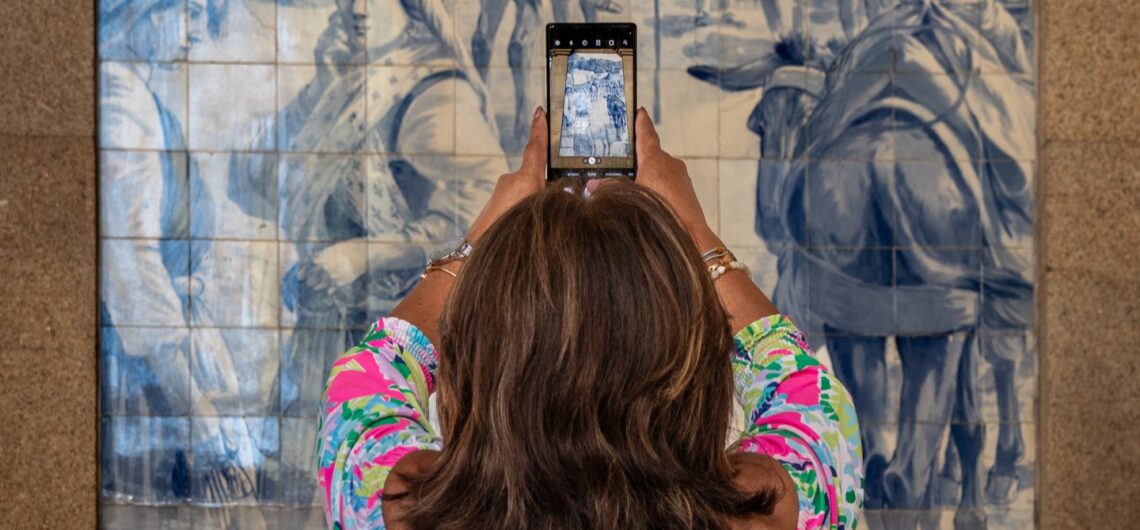São Bento Railway Station, located in the vibrant heart of Porto, Portugal, is more than just a transportation hub — it’s a stunning artistic masterpiece adorned with captivating blue-and-white tile murals, known as azulejos.
With approximately 20,000 tiles, these murals narrate significant historical scenes and are an absolute delight for photographers and history enthusiasts alike.
In this post, we’ll explore the mesmerizing azulejos, their rich historical context, artistic significance, and offer expert tips for capturing their beauty through photography. Check it out!
The historical and artistic significance of São Bento’s Azulejos
São Bento Railway Station was inaugurated in 1916, but its iconic azulejos were completed earlier, between 1905 and 1916, by renowned Portuguese artist Jorge Colaço. These tiles intricately depict historical events, landscapes, and everyday scenes that hold cultural significance to the Portuguese people.
Azulejos, a form of Portuguese painted ceramic tiles, have been central to Portugal’s visual culture since the 15th century. The distinctive blue-and-white colors of São Bento’s azulejos trace back to influences from Delft pottery, imported from the Netherlands in the 17th century, symbolizing Portugal’s openness to foreign artistic traditions while cultivating its own.
When visiting São Bento Station, photographers will encounter murals illustrating scenes such as the Battle of Valdevez, historical events from Portugal’s Age of Discovery, and depictions of traditional rural life in northern Portugal. Each tile is painstakingly detailed, making this a location ideal for both wide shots and detailed close-ups.
Best angles to photograph São Bento’s Azulejos
Capturing the essence of São Bento Station requires thoughtful positioning and composition:
- Wide-Angle Shots: utilize a wide-angle lens to encompass the grand scale of the murals within the station’s main hall. Position yourself centrally to frame symmetrical compositions, emphasizing the impressive scale and visual harmony of the tiles;
- Detail and Texture: for detailed shots, focus closely on individual tiles or small groups. Highlighting intricate scenes and patterns reveals the depth and artistic complexity of the artwork. A macro lens can greatly assist in capturing the fine details and textures;
- Perspective and Framing: consider incorporating architectural elements like arches, windows, and columns into your shots. This technique creates dynamic compositions and offers unique visual perspectives that further enhance the storytelling quality of your photographs.
Ideal lighting conditions
Lighting can dramatically affect your photography of São Bento’s azulejos. The station is naturally illuminated through large windows and skylights, providing beautiful, diffused daylight.
Photographing early in the morning is particularly advantageous. Not only will you encounter fewer crowds, but the softer natural lighting also reduces glare on the tiles, enhancing their natural hues and subtle contrasts.
Late afternoon, known as the golden hour, also offers excellent lighting conditions. Just before sunset, warm tones flood through the station’s windows, adding richness and warmth to your images. Additionally, shadows during this period help emphasize texture and depth, creating striking photographs.
Conversely, it’s best to avoid photographing during midday. The harsh overhead sunlight can wash out colors and flatten details, detracting from the beauty and intricacy of the azulejos.
Experience a personalized photographic tour with local experts. Discover São Bento’s hidden details and learn professional photography techniques — explore our tours today!
Tips for photographing São Bento Station
To ensure you get exceptional shots, follow these practical photography tips:
- Use a tripod: using a tripod stabilizes your camera, allowing you to experiment with lower shutter speeds to capture crisp images, especially in the lower lighting conditions of early morning and late afternoon;
- Composition techniques: utilize the rule of thirds, symmetry, and leading lines to structure your compositions compellingly. The station’s architecture provides ample opportunities to practice these foundational composition techniques;
- Be patient with crowds: as a busy railway station, São Bento can be crowded. Wait patiently for quieter moments, or creatively incorporate people to give context and scale to your photographs.
Beyond the azulejos: capturing the Station’s atmosphere
While the azulejos are the stars, São Bento Station offers other photographic delights. Capture scenes of travelers in motion, the rhythmic movement of trains, or the architectural elegance of the building itself. These elements collectively convey the dynamic spirit and historical significance of the station.
Don’t forget to explore different vantage points — staircases, balconies, and even the exterior facade — to fully appreciate and capture the station’s aesthetic diversity.
Editing tips to enhance your Azulejo photography
Post-processing can further enhance the beauty of São Bento’s azulejos:
- Adjust exposure and contrast gently to emphasize details without losing the subtlety of colors;
- Enhance clarity slightly to highlight tile textures and details;
- Fine-tune white balance to accurately represent the natural blue tones characteristic of azulejos.
Ready to capture São Bento’s beauty through your lens?
Experience the history, art, and vibrant atmosphere of São Bento Railway Station firsthand. Join Pictury Photo Tours and transform your visit into lasting photographic memories.



